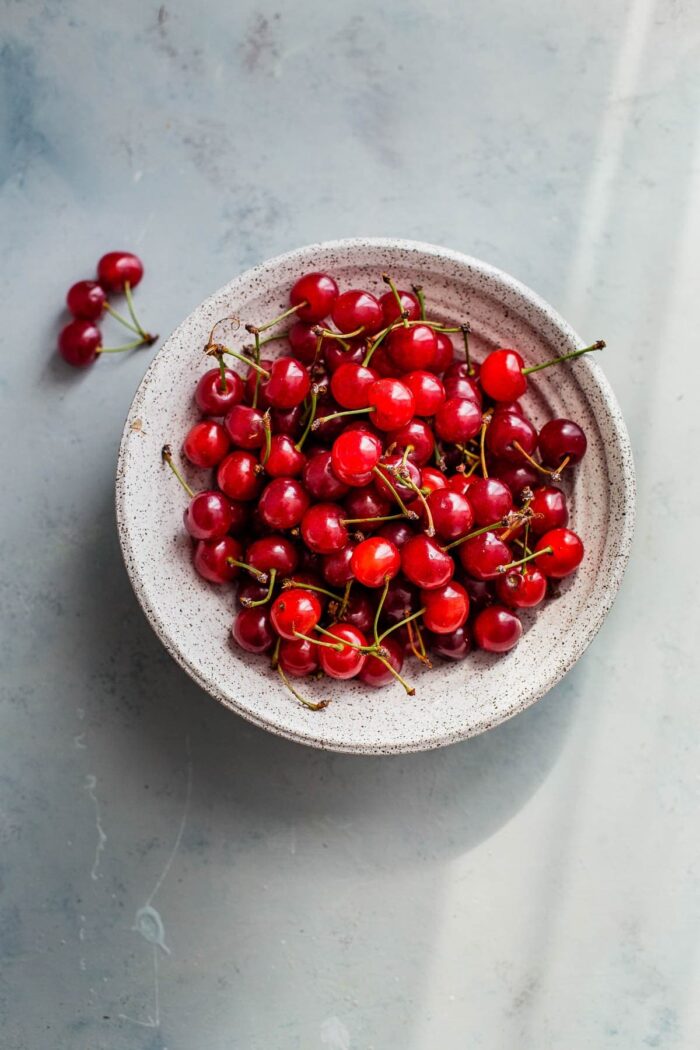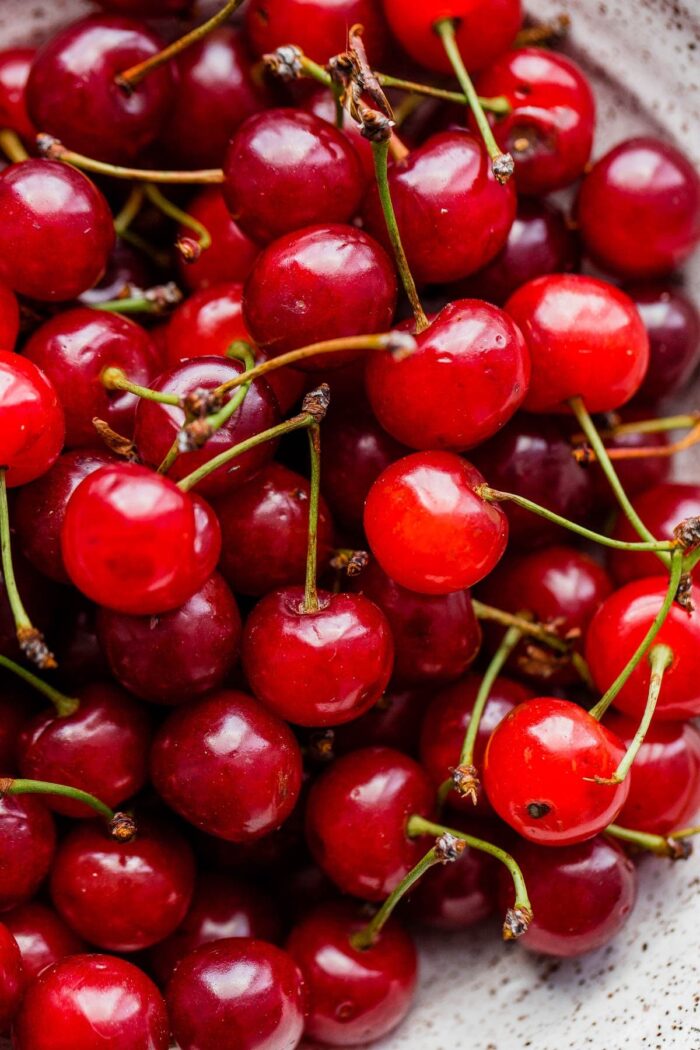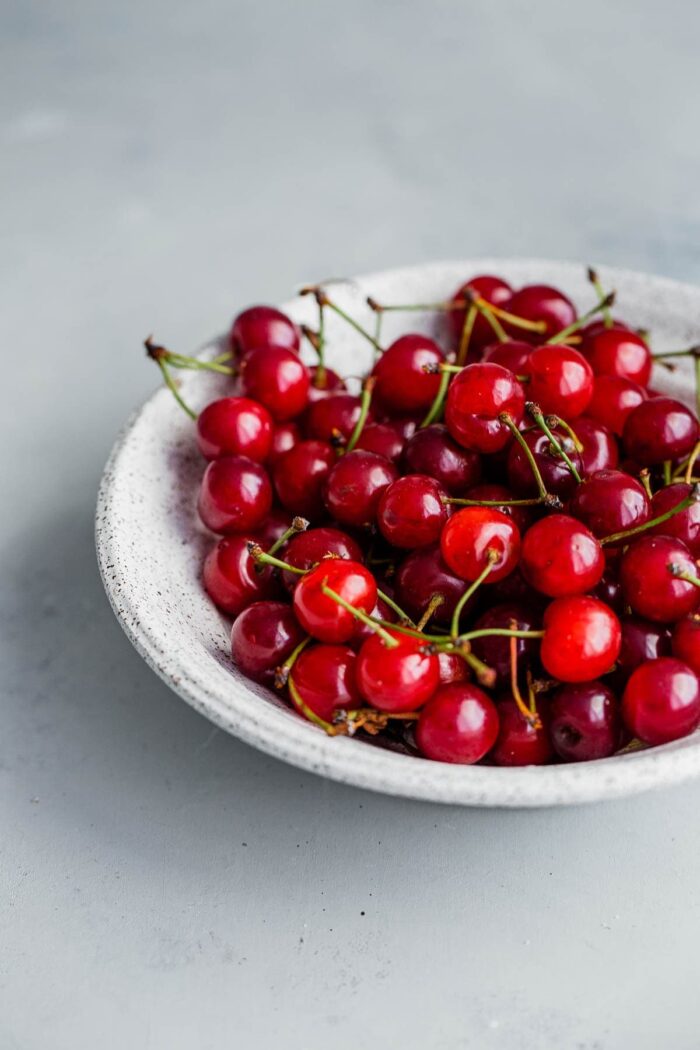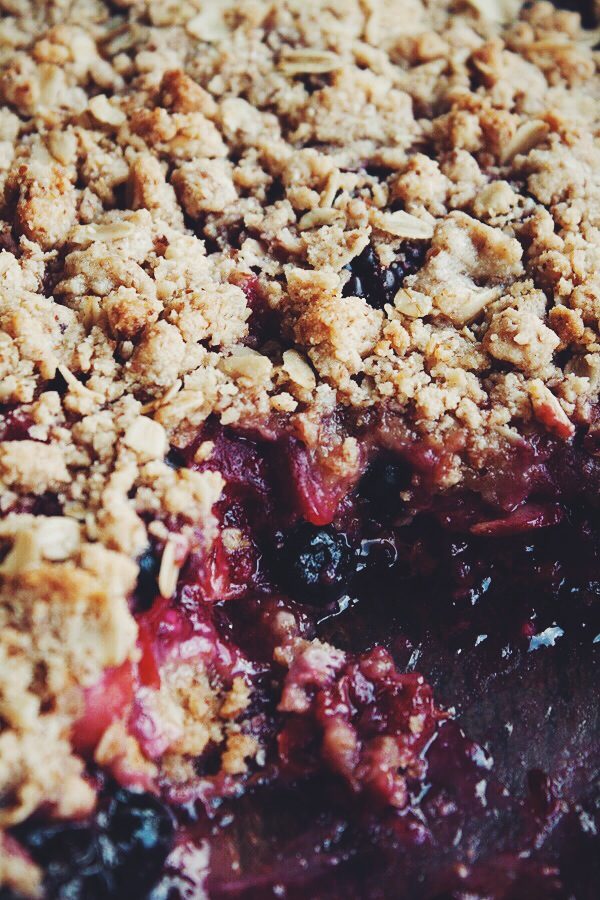Ingredient Spotlight: Sour Cherries

We’re sharing another ingredient spotlight post! Today, we’re talking cherries. Specifically, sour cherries. Those beautiful, bright red cherries appear at farmer’s markets only a few short weeks of the year.
I rarely came across sour cherries when I lived on the East Coast. In fact, this sour cherry berry crisp was my first time baking with them! We’re lucky to find fresh Michigan sour cherries in the Chicago area. The season doesn’t last long, so you have to take advantage when you find them.
While you can certainly snack on sour cherries, their tart flavor and low sugar content lend themselves well to baking (or jamming) applications, where you have better control over sweetness levels.

Sour Cherry Varieties:
There are three major varieties of sour cherries available: Montmorency (shown above), Morello, and Early Richmond. They all vary in color (Montmorency are very bright red) and tartness. Fun fact? Sour cherries are light sensitive and will actually darken in color when exposed to artificial or natural light.
How to Pick and Store Sour Cherries
Unlike regular cherries, sour cherries are slightly softer, so I try my best to use them within a day or two of buying them. Like any cherry, you want to seek out firm-fleshed cherries with the stems attached as those will hold up the longest. Avoid cherries without stems, as they will become mushy more quickly.
Cherries should be stored in the refrigerator to prolong their shelf life. Unlike other stone fruit, cherries do not improve in flavor or texture once picked, so it is best to consume them as soon as possible. If you have a sour cherry surplus? Remove the pits, lay them on a parchment lined baking sheet, freeze, and transfer to a Ziploc bag for another time.

The Easiest Way to Pit Cherries:
If you enjoy baking and cooking with fresh berries, I highly recommend investing in a good-quality cherry pitter!
I resisted for 27 years of my life and love my cherry pitter. They are affordable and it is the only thing coming between you and homemade cherry pie (or any dessert that calls for a large number of cherries). While there are a million and one “hacks” for pitting cherries, they’re quite messy and cumbersome.
The More You Know: If you don’t enjoy pitting cherries (or are just feeling lazy – don’t blame you!), one of the most traditional desserts that you can prepare is a classic French cherry clafoutis. Traditionally, cherry clafoutis are made with unpitted cherries. When cooked or heated, cherry pits develop a strong almond flavor, which is what lends clafoutis its signature taste.

Sour Cherry Recipe Ideas:
- Sour Cherry Berry Crisp
- Sour Cherry Crumb Bars (Washington Post)
- Perfect Sour Cherry Jam (Serious Eats)
- Sour Cherry Frozen Yogurt (Lottie + Doof)
- Sour Cherry Pie (Serious Eats)
For more inspiration, visit our other Ingredient Spotlight posts.

10 Comments on “Ingredient Spotlight: Sour Cherries”
thanks so much, heading there tomorrow morning!!!
hi, wondering if you would mind sharing which chicago farmers market you found the sour cherries? we need them for an upcoming photo shoot and need to get our hands on them this weekend. thanks, jennifer
Green City farmers market in Lincoln Park would be your best bet, but I don’t know if they’re even available at farmers markets yet (I would think so, but I was traveling last weekend and haven’t seen them yet myself!). It’s all so dependent on seasonality, and this post is not recently published. Hope that helps!
Wow, so many great tips here on cherries. And I didn’t realize that you should eat them straight away. Good to know!!
Pingback: Currently Crushing On. | How Sweet It Is
I don’t think I have ever seen ANY cherries at our farmer’s market. I don’t think they thrive very well here (although I do know some people that grow them). I am really enjoying your ingredient spotlights. I know they are not exciting, but I would love to see some ingredients that are a bit difficult to work with… turnips, beets. Both can be good, but are a bit limited.
Sadly, I think it really just depends on what grows where! Where do you live? Thank you so much for the feedback on the Ingredient Spotlight series Ben! I’m thinking about mixing it up with more difficult-to-find versus easier ingredients (like you mentioned!). I totally agree – I think it could be fun to showcase some ingredients that people don’t use very often (or know what to do with). Appreciate the kind words!
I have never seen sour cherries at our farmer’s market or seen them for sale in a store. While I live in part of California where much farming is done I have never been able to find any sour cherries and we pick fruit at “you pick” farms each year. You are fortunate to live where these are available. I can’t even find them frozen (tried Whole Foods too) so the only way I have ever seen these is commercially canned. I will just remind myself that we live where Blenheim Royal apricots are grown, the best on the planet! We picked over a hundred pounds this year.
I’m so jealous! I’ve truthfully never had a GREAT fresh apricot (and I love them!). I tend to end up roasting them to bring out their flavor a bit, because I never start with great, great ones. I’ve never seen frozen sour cherries at the grocery store. I’ve read that most are processed (perhaps for canned cherries?). Wish I could send you some!
I read about your recent visit to family in Oakland, California. That is just a few miles from the area where we picked the Blenheim Royal Apricots. You need to time a visit one year during apricot season and visit Brentwood in Contra Costa County a few miles from Oakland. There is a large area there that is an agricultural land trust full of farms. The area will remain agricultural, a lot of the produce that is sold at farmer’s markets in the Bay Area comes from that area. We always pick our apricots at the Farmer’s Daughter Produce and U-Pick orchard. They have peaches and nectarines too. Other farms in the area grow cherries but I have never seen one with sour cherries.